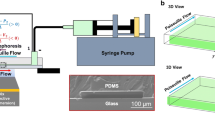Abstract
This article analyzes the behavior of a nanoparticle suspension in a dense and viscous fluid under dielectrophoresis (DEP), a phenomenon which induces spatial movement, depending on the dielectric properties of the particles and the surrounding medium. The dielectrophoretic forces and the nanoparticle concentration profile in a DEP-based separation micro system, consisting of a microchannel, were numerically investigated using a finite element code. In particular, the trajectories described by the particle movement for a planar electrode array configuration were simulated, and the vertical variation of the dielectrophoretic force, as a function of the rectangular electrodes’ height, was analyzed. This article shows how, by carefully selecting the design parameters of several microchannel devices, one can extend the applications of DEP phenomena to the nanoscale.











Similar content being viewed by others
References
Abboud H, El Chami F, Sayah T (2011) A priori and a posteriori estimates for three-dimensional Stokes equations with nonstandard boundary conditions. Numer Methods Partial Differ Equ. doi:10.1002/num.20676, http://hal.archives-ouvertes.fr/hal-00442468
Castellanos A, Ramos A, Gonzales G, Green NG, Morgan H (2003) Electrohydrodynamics and dielectrophoresis in microsystems: scaling laws. J Phys D Appl Phys 36:2584–2597, PII: S0022-3727(03)63619-3
Chu K-HW (2008) Study of the electric potential inside wavy-rough annuli interface. Electrochim Acta 53:4920–4926. doi:10.1016/j.electacta.2008.02.017
Crews N, Darabi J, Voglewede P, Guo F, Bayoumi A (2007) An analysis of interdigitated electrode geometry for dielectrophoretic particle transport in micro-fluidics. Sens Actuators, B 125:672–679
Grebenkov DS, Filoche M, Sapoval B (2006) Mathematical basis for a general theory of Laplacian transport towards irregular interfaces. Phys Rev E 73:021103-1–021103-9, doi:10.1103/PhysRevE.73.021103
Green NG, Morgan H (1998) Separation of submicrometre particles using a combination of dielectrophoretic and electrohydrodynamic forces. J Phys D Appl Phys 31:L25-L30, PII: S0022-3727(98)90251-0
Green NG, Ramos A, Morgan H (2002) Numerical solution of the dielectrophoretic and travelling wave forces for interdigitated electrode arrays using the finite element method. J Electrostat 56:235–254
Hamed MA, Yariv E (2009) Induced-charge electrokinetic flows about polarizable nano-particles: the thick-Debye-layer limit. J Fluid Mech 627:341–360. doi:10.1017/S0022112009005965
Hecht F, Pironneau O (2012) FreeFEM ++. Available online at http://www.freefem.org
Holmes D, Green NG, Morgan H (2003) Microdevices for dielectrophoretic flow-through cell separation. IEEE Eng Med Biol Magaz 22:85–90. doi:10.1109/MEMB.2003.1266051
Hughes MP (2000) AC electrokinetics: applications for nanotechnology. Nanotechnology 11. doi:10.1088/0957-4484/11/2/314
Jones TB (2003) Basic theory of dielectrophoresis and electrorotation. IEEE Eng Med Biol Magaz 22:33–42. doi:10.1109/MEMB.2003.1304999
Lamoreaux SK (2005) The Casimir force: background, experiments and applications. Rep Prog Phys 68:201–236. doi:10.1088/0034-4885/68/1/R04
Lin P, Liu C, Zhang H (2007) An energy law preserving C0 finite element scheme for simulating the kinematic effects in liquid crystal dynamics. J Comput Phys 227:1411–1427. doi:10.1016/j.jcp.2007.09.005
Lungu M, Neculae A, Bunoiu M (2010) Some considerations on the dielectrophoretic manipulation of nanoparticles in fluid media. J Optoelectron Adv Mater 12:2423–2426
Morgan H, Green NG (2003) AC electrokinetics: colloids and nanoparticles. In: Research Studies Ltd. Baldock, Hertfordshire, 50–62, 200–210
Pethig R (2010) Review article—dielectrophoresis: status of the theory, technology, and applications. Biomicrofluidics 4:022811-1–02281-34. doi:10.1063/1.3456626
Rao L, Reddy NK, Coulombe S, Meunier JL, Munz RJ (2007) Carbon nanotubes as nanoparticles collector. J Nanopart Res 9:689–695. doi:10.1007/s11051-006-9175-5
Shklyaev S, Straube AV (2008) Particle entrapment in a fluid suspension as a feedback effect. New J Phys 10:063030. doi:10.1088/1367-2630/10/6/063030
Zhang C, Khoshmanesh K, Mitchell A, Kalantar-Zadeh K (2010) Dielectrophoresis for manipulation of micro/nano particles in microfluidic systems. Anal Bioanal Chem 396:401–420. doi:10.1007/s00216-009-2922-6
Acknowledgments
This study was supported by a grant of the Romanian National Authority for Scientific Research, CNCS—UEFISCDI, project number PN-II-ID-PCE-2011-3-0762. C. G. Biris was partially supported by the grant FP7-REGPOT-2011-1-284595 (HOST).
Author information
Authors and Affiliations
Corresponding author
Rights and permissions
About this article
Cite this article
Neculae, A., Biris, C.G., Bunoiu, M. et al. Numerical analysis of nanoparticle behavior in a microfluidic channel under dielectrophoresis. J Nanopart Res 14, 1154 (2012). https://doi.org/10.1007/s11051-012-1154-4
Received:
Accepted:
Published:
DOI: https://doi.org/10.1007/s11051-012-1154-4




